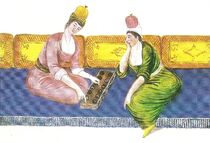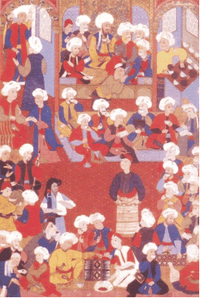Mangala → Italian.
| Mangala |
| Other Names: Mangola |
| First Description: Thomas Hyde,1694 |
| Cycles: One |
| Ranks: Two |
| Sowing: Single laps |
| Region: Greece, Turkey, Ukraine |
Mangala is a Turkish mancala game which was very popular in the 17th and 18th century. According to Metin And, a Turkish ethnologue, the game could be related to the "mancala" of The Arabian Nights (fifteenth night), one of the first literary accounts of mancala games. The game was depicted in Turkish paintings as early as in the 16th century. In Europe, it was first mentioned in 1664 by the French traveller Jean de Thévenot in his account "Relation d'un voyage fait au Levant". In 1694, the game was mentioned by the English traveller Thomas Hyde in a list of approximately 30 games. Mangala was very popular in Constantinople in 1771, when it was observed by the French traveller Pierre Augustin Guys. The game was also found by Edward Daniel Clarke in Balaklava, Crimea (now a suburb of Sevastopol, Ukraine) in 1801 and by Peter Emund Laurent on Chios Island (now Greece) in 1818. It was also mentioned in two popular novels that were published in the early 19th century in London: "Ida of Athens" (1809) and "Anastasius" (1819). Mangala might have influenced Mandoli (Hydra Island, Greece) and Ban-Ban (Bosnia). Its rules are similar (but not identical) to the Baltic German Bohnenspiel, which originated in Persia where it was known as Manqala or Manqalat.

Two Ottoman Women Playing Mangala (18th century)
The classic Mangala is still known in Turkey. However, the Mangala played in Gaziantep in Southeast Anatolia is not related to it at all, but is a close variant of La'b Madjnuni ("The Crazy Game"), which was played in Damascus (Syria) in the late 19th century. More games called "Mangala" (again with quite different rules) are popular among the Bedouins in Egypt.
Mangala might be the first commercialized mancala game in a western country. A game called "mangola" (a common synonym for the Turkish Mangala at this time) was published by Jaques in England in 1863, after Walter Whitmore Jones claimed to have invented it. Jaques pattern book covering shows a thick wood board with two rows of six cells in which something like white beans are placed. The records of copyrights kept by the Stationers company, the Public Records Office at Kew, includes a volume covering 1862-64, which has an entry showing that the rules of Mangola were protected by copyright at that time. Richard Ballam, a board games collector, found an advertisement in the Illustrated London News (December 23, 1865) saying: "Mangola, a new game. By the author of Squails, Frogs & Toads etc. Wholesale Jaques & Son". Claiming foreign or nearly forgotten boardgames as own designs happens frequently in the game industry. A minor change of the rules and the game can be copyrighted. Well-known examples are Pente, which is a simplified variation of the Japanese Ninuki Renju (and not an invention of Gary Gabrel), and Othello, a variation of Reversi with just half the game-tree complexity (and not an invention of Goro Hasegawa). See also Chuba.
Quotes
"Le Mangola est un jeu Turc , qui se joue avec de petites coquilles."
Jean-Antoine Guer (1747)
"We observed a game here quite new to us: The Greeks call it Mangala. I have since observed it at Constantinople. It is played with a board having two rows of parallel partitions: into each of these was placed a certain number of small shells, such as the natives of Guinea use for money."
Edward Daniel Clarke (1801)
"The town itself is very large and populous; it abounds in coffeehouses, at each of with both Greeks and Turks are seen drinking coffee and smoking their pipes with countenances marked by the greatest indifference and inactivity; many are seen playing at chess and oriental game of mangala."
Peter Emund Laurent (1818)
"There is lots of strategy in this game, yet planning cannot be done when the player is playing since the transfer from one hole to another requires very speedy action, so thinking is done when the other player is playing."
Metin And (1979)
Rules

Mangala at Turkish Cafes (16th century)
Mangala is played on a board, which consists of 12 holes dug into the earth. Initially there are six glass beads ("boncuğu") or cowrie shells in each hole.
Initial Position
On his turn a player distributes the contents of a hole, one by one, in a counter-clockwise direction into the succeeding holes.
If the last bead falls in a hole on either side of the board, making a total of two, four or six beads including the last bead, its contents are captured.
If this hole is preceded by other holes which contain two, four or six beads, their contents are also taken.
A player must move if he can, but passes when his holes are empty.
The game is finished when all holes are empty.
The player who captured more beads wins the game.
See also
External Links
- Metin And
- Another engraving of Turkish Girls playing Mangala from the 18th century (Stapleton Collection)
References
- Abu abd-Allah Muhammed el-Gahshigar.
- Hezār wa-Yek Shab (Kitāb Alf Layla wa-Layla). Baghdad, Sassanid Persia 8th-9th century AD.
- And, M.
- Cocuk Oyunlarinin Kültürümüzde Yeri Ve Önemi. In: Ulusal Kültür: Üc Ayhk Kültür Dergisi 1979 (4).
- And, M.
- Some Notes on Aspects and Functions of Turkish Folk Games. In: The Journal of American Folklore 1979; 21 (1) 44-64.
- Clarke, E. D.
- Travels in Various Countries of Europe, Asia, and Africa (Greece, Egypt, and the Holy Land, Part II). T. Cadell & W. Davies, London 1811, 520.
- Guer, J.-A.
- Moeurs et usages des Turcs, leur religion, leur gouvernement civil, militaire et politique: leur religion, leur gouvernement civil, militaire et politique, avec un abregé de l'histoire ottomane. Pierre Mortier, Leiden (Netherlands) 1747.
- Güllü, A.
- Mangala Oyunu Nedir? In: Elbistan Kaynarca Gazetesi November 29, 2007.
- Guys, P. A.
- A Sentimental Journey through Greece. In a Series of Letters, written from Constantinople. J. Milliken, London (UK) 1772 (1st Edition).
- Hope, T.
- Anastasius; or, Memoirs of a Greek. John Murray, London (UK) 1819 (Vol. I), 119.
- Hyde, T.
- De Ludis Orientalibus. Oxford (England) 1694, 226-232.
- Laurent, P. E.
- Recollections of a Classical Tour Through Various Parts of Greece, Turkey, and Italy. G. and W. B. Whittaker, London 1821, 27.
- Owenson, S.
- Woman; or, Ida of Athens. Longman, Hurst, Rees, and Orme, London (UK) 1809, 164.
- Shoberl, F.
- Turkey: Being a Description of the Manners, Customs, Dresses, and Other Peculiarieties, Characteristic of the Inhabitants of the Turkish Empire; To Which Is Prefixed a Sketch of the History of the Turks. R. Ackerman, London (England) 1821, 220-222.
- Steingass, F. J.
- A Comprehensive Persian-English Dictionary, Including the Arabic Words and Phrases to Be Met with in Persian Literature. Routledge & K. Paul, London (England) 1892, 1333.
- Thévenot, J. de
- Relation d'un voyage fait au Levant dans laquelle il est curieusement traité des estats sujets au Grand Seigneur et des singularitez particulières de l'Archipel, Constantinople, Terre-Sainte, Égypte, pyramides, mumies, déserts d'Arabie, la Meque, et de plusieurs autres lieux de l'Asie et de l'Affrique outre les choses mémorables arrivées au dernier siège de Bagdat, les cérémonies faites aux réceptions des ambassadeurs du Mogol et l'entretien de l'autheur avec celuy du Pretejan, où il est parlé des sources du Nil. Paris (France), 1664.
- Tokuz, G.
- Yüzyılda Gaziantep'te Eğlence Hayatı (Gaziantep Üniversitesi Vakfı Yayını No. 14.). Gaziantep (Turkey) 2004.
Copyright
© Wikimanqala.
By: Ralf Gering
Under the CC by-sa 2.5 license.
